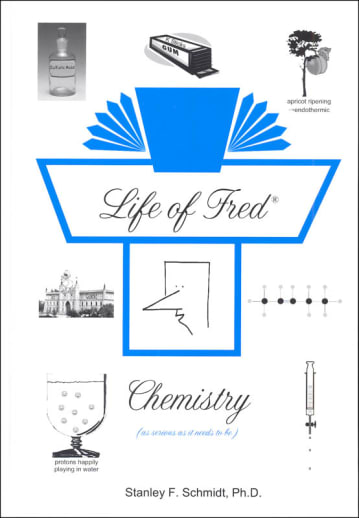Have you been longing for a high school science course written like the Life of Fred math curriculum? Story format? Tongue in cheek humor? Cute little sidebar comments and rabbit trails that keep you reading? Dr. Stanley Schmidt has done it Life of Fred Chemistry! Get your high school credit for chemistry in a very non-traditional way. The goal of Dr. Schmidt's chemistry course is to teach you the "really basic stuff such as the chemical symbol for carbon is C and that organic compounds are those that contain carbon because to be a "well-educated adult, you probably don't need to learn what a racemic mixture means.
The story begins at the chem lab down the hall from Fred's math class when Joe didn't follow proper lab safety and gets hurt (I don't want to give away too much of the story). Through this scenario, students will learn about lab safety and the story proceeds from there as students learn about the size of gold atoms; weighing an atom; mass vs. weight; standard temperature; mole; scientific method and much more as the story unfolds.
There are 36 short chapters and each concludes with Your Turn to Play. This is a set of questions (including math problems) to make sure you understand each chapter's concepts. Complete solutions are found on the reverse side of the Your Turn to Play page. Note: there are no tests or labs to accompany this course. If you really want to do this course but need it to be a lab science, you could add the MicroChem Experiment Lab Kit (#020028). This self-contained lab kit comes with the chemicals needed and complete instructions (since no labs come in the Life of Fred Chemistry text). If you feel confident in your lab abilities, you could add the Illustrated Guide to Home Chemistry Experiments (#027801) or 150 Captivating Chemistry Experiments Using Household Substances (#005436). Either of these books would allow you to add labs using familiar substances rather than hard-to-access chemicals. Dr. Schmidt recommends the use of a scientific calculator with the keys sin, cos, log, and ln. These are inexpensive calculators and we have one in the Rainbow Resource inventory that meets his key' recommendation, #041918.
Algebra is always a prerequisite to doing chemistry; this course is no exception. The math begins on page 1 of the text with simplifying algebra equations. The math isn't heavy, but you need to know your algebraic functions. Dr. Schmidt says that you need enough beginning algebra to understand basic algebra concepts.
Dr. Schmidt believes that if chemistry is taught right, it can be a lot of fun! Do this as your stand-alone chemistry (with lab supplementation if desired) or read it alongside your chemistry curriculum to add that humorous element and have fun! ~ Donna

